All‑Cause mortality of atrial fibrillation and heart failure in the same patient: Does the order matter?
Tímea Papp, György Rokszin, Zoltán Kiss, Dávid Becker, Béla Merkely, Zoltán Járai, András Jánosi, Zoltán Csanádi (Cardiology and Therapy, https://doi.org/10.1007/s40119-024-00378-1)

Introduction
Atrial fibrillation (AF) and heart failure (HF) often coexist due to the common elements of the pathomechanism they share. The potential significance of the order these entities present in the same patient is ill-defined. Herein, we report our results from a nationwide database on the occurrence of various sequences AF and HF may present, the time delays between the two conditions and all-cause mortality associated with different scenarios.
Methods
Patients diagnosed with both AF and HF between 2015 and 2021 were enrolled from the Hungarian National Health Insurance Fund (NHIF) database. The order the two entities followed each other, and the time delay in between were registered. Median survival rates were calculated in AF → HF; HF → AF and simultaneous scenarios.
Results
A total of 109,075 patients were enrolled: 29,937 with AF → HF, 38,171 with HF → AF, and 40,967 diagnosed simultaneously. Time delays between AF → HF and HF → AF were 6 and 10 months, respectively. The median survival was 46 months in the AF → HF, 38 months in the HF → AF, and 21 months in the simultaneous group. Patients with HF → AF, and with simultaneous presentations had 5% and 16% greater mortality risk as compared to the AF → HF sequence, with hazard ratios (95% confidence intervals) of 0.95 (0.93–0.97) and 0.84 (0.82–0.85), respectively (P < 0.0001).
Conclusions
HF occurred significantly earlier after the diagnosis of AF than vice versa. Patients diagnosed simultaneously had the worst, while the AF → HF sequence had the best prognosis. These data should have implications for the intensification of monitoring and therapy in different scenarios.
